The Impact of Topographic Relief on Population and Economy in the Southern Anhui Mountainous Area, China
Abstract
1. Introduction
2. Materials and Methods
2.1. Study Area
2.2. Data Sources and Processing
2.3. Research Framework and Methods
2.3.1. Research Framework
2.3.2. Preliminary Extraction of Topographic Relief
2.3.3. Quadratic Extraction of Topographic Relief
3. Results
3.1. Spatial Distribution of Topographic Relief
3.2. Impact of Topographic Relief on the Spatial Pattern of Population and Economy
3.2.1. Comparative Analysis of the Impact of Slope and Elevation on Population and Economy
3.2.2. Impact of Topographic Relief on Spatial Distribution of Population and Economy
4. Discussion
4.1. Impacts of Topographic Relief on Population and Economy
4.2. Relationship between Topographic Relief and GDP of Three Industries
4.3. Correlation between Topographic Factors
4.4. Selection of Statistical Units
5. Conclusions
Author Contributions
Funding
Institutional Review Board Statement
Informed Consent Statement
Data Availability Statement
Conflicts of Interest
Appendix A
| No. | County Name | Area | Population Density | Economic Density | Primary Industry Density | Secondary Industry Density | Tertiary Industry Density |
|---|---|---|---|---|---|---|---|
| km2 | Person/km2 | 106 Yuan/km2 | |||||
| 1 | Tunxi | 194.13 | 1500.03 | 105.52 | 2.76 | 30.22 | 72.54 |
| 2 | Huangshan | 1750.70 | 83.91 | 6.83 | 0.58 | 2.06 | 4.19 |
| 3 | Huizhou | 425.98 | 225.83 | 20.19 | 1.06 | 10.01 | 9.13 |
| 4 | Guichi | 2512.93 | 244.85 | 14.09 | 1.45 | 6.12 | 6.52 |
| 5 | Fanchang | 571.96 | 426.43 | 54.62 | 2.16 | 30.95 | 21.50 |
| 6 | Xuanzhou | 2632.08 | 294.18 | 16.57 | 1.81 | 6.40 | 8.37 |
| 7 | Ningguo | 2427.52 | 159.88 | 15.84 | 1.06 | 9.18 | 5.60 |
| 8 | Guangde | 2110.95 | 236.43 | 15.62 | 1.26 | 7.44 | 6.92 |
| 9 | Huashan | 178.55 | 2525.93 | 235.41 | 0.94 | 71.96 | 162.51 |
| 10 | Yushan | 173.55 | 2051.32 | 130.03 | 1.41 | 35.51 | 93.12 |
| 11 | Bowang | 368.72 | 429.86 | 35.77 | 2.54 | 17.86 | 15.38 |
| 12 | Tongguan | 133.33 | 3381.94 | 235.81 | 0.38 | 82.28 | 153.23 |
| 13 | Jiaoqu | 555.46 | 295.61 | 24.63 | 2.05 | 12.04 | 10.53 |
| 14 | Yi’an | 805.83 | 282.32 | 19.71 | 1.80 | 8.26 | 9.65 |
| 15 | Jinghu | 115.99 | 4126.97 | 574.70 | 2.29 | 89.67 | 482.74 |
| 16 | Yijiang | 516.80 | 817.72 | 90.86 | 0.68 | 50.52 | 39.66 |
| 17 | Jiujiang | 883.33 | 611.89 | 57.19 | 2.36 | 23.28 | 31.55 |
| 18 | Wanzhi | 646.40 | 532.17 | 51.05 | 3.49 | 26.53 | 21.04 |
| 19 | Wuwei | 2005.86 | 407.81 | 25.48 | 2.80 | 12.37 | 10.31 |
| 20 | Shexian * | 2117.49 | 171.43 | 9.45 | 0.94 | 3.42 | 5.09 |
| 21 | Xiuning * | 2113.23 | 100.08 | 5.50 | 0.72 | 2.17 | 2.62 |
| 22 | Yixian * | 855.72 | 89.05 | 5.33 | 0.52 | 1.76 | 3.05 |
| 23 | Qimen * | 2211.52 | 65.84 | 3.51 | 0.34 | 1.10 | 2.07 |
| 24 | Dongzhi * | 3263.23 | 122.09 | 6.48 | 1.01 | 2.73 | 2.74 |
| 25 | Shitai * | 1428.48 | 56.42 | 1.98 | 0.36 | 0.44 | 1.18 |
| 26 | Qingyang * | 1193.43 | 208.22 | 11.93 | 1.12 | 4.97 | 5.84 |
| 27 | Nanling * | 1266.66 | 340.34 | 22.22 | 2.84 | 9.45 | 9.92 |
| 28 | Jingxian * | 2035.24 | 135.51 | 6.40 | 0.98 | 2.48 | 2.94 |
| 29 | Jixi * | 1111.74 | 124.85 | 7.94 | 1.29 | 3.56 | 3.10 |
| 30 | Jingde * | 903.25 | 124.44 | 6.08 | 0.94 | 2.48 | 2.67 |
| 31 | Langxi * | 1101.90 | 282.69 | 16.66 | 1.75 | 8.87 | 6.05 |
| 32 | Dangtu * | 977.79 | 457.15 | 47.40 | 3.52 | 24.05 | 19.84 |
| 33 | Hexian * | 1316.76 | 312.05 | 20.26 | 2.15 | 7.37 | 10.74 |
| 34 | Hanshan * | 1034.21 | 325.47 | 19.75 | 2.23 | 7.65 | 9.87 |
| 35 | Zongyang * | 1488.38 | 315.17 | 11.30 | 2.02 | 2.78 | 6.50 |
References
- Yu, H.; Luo, Y.; Liu, S.Q.; Wang, Y.; Yang, Y. The influences of topographic relief on spatial distribution of mountain settlements in Three Gorges Area. Environ. Earth Sci. 2015, 74, 4335–4344. [Google Scholar]
- Fang, Y.P.; Ying, B. Spatial distribution of mountainous regions and classification of economic development in China. J. Mt. Sci. 2016, 13, 1120–1138. [Google Scholar] [CrossRef]
- Li, Y.J.; Yang, X.H.; Cai, H.Y.; Xiao, L.L.; Xu, X.L.; Liu, L. Topographical characteristics of agricultural potential productivity during cropland transformation in China. Sustainability 2015, 7, 96–110. [Google Scholar] [CrossRef]
- Dai, E.F.; Wang, Y.H.; Ma, L.; Yin, L.; Wu, Z. ‘Urban-Rural’ Gradient Analysis of Landscape Changes around Cities in Mountainous Regions: A Case Study of the Hengduan Mountain Region in Southwest China. Sustainability 2018, 10, 1019. [Google Scholar] [CrossRef]
- Adam, A.; Roksana, Z.; Grzegorz, W. Changes in the topography of Krakow city centre, Poland, during the last millennium. J. Maps 2021, 17, 186–193. [Google Scholar]
- Ajczak, A.; Zarychta, R.; Waek, G. Quantitative assessment of changes in topography of town caused by human impact, Krakow city centre, southern Poland. Remote Sens. 2021, 13, 2286. [Google Scholar] [CrossRef]
- Ma, X.L.; Jin, Y.L. The characteristics and mechanism of land selection under Zhangjiajie tourism development. Areal Res. Dev. 2016, 35, 127–131, 180. [Google Scholar]
- Zhang, S.; Zhao, K.; Ji, S.; Guo, Y.; Wu, F.; Liu, J.; Xie, F. Evolution characteristics, eco-environmental response and influencing factors of production-living-ecological space in the Qinghai–Tibet Plateau. Land 2022, 11, 1020. [Google Scholar] [CrossRef]
- Meybeck, M.; Green, P.; Vörösmarty, C. A new typology for mountains and other relief classes. Mt. Res. Dev. 2001, 21, 34–45. [Google Scholar] [CrossRef]
- Feng, Z.M.; Zhang, D.; Yang, Y.Z. Relief degree of land surface in China at county level based on GIS and its correlation between population density and economic development. Jilin Univ. J. Soc. Sci. Edit. 2011, 51, 146–151. [Google Scholar]
- Feng, Z.M.; Tang, Y.; Yang, Y.Z.; Zhang, D. The relief degree of land surface in China and its correlation with population distribution. Acta Geogr. Sin. 2007, 62, 1073–1082. [Google Scholar]
- Zhang, J.J.; Zhu, W.B.; Zhu, L.Q.; Cui, Y.P.; He, S.S.; Ren, H. Topographical relief characteristics and its impact on population and economy: A case study of the mountainous area in western Henan, China. J. Geogr. Sci. 2019, 29, 598–612. [Google Scholar] [CrossRef]
- Zhang, J.J.; Li, Y.H.; Zhu, L.Q. Relief amplitude based on county units in west Henan mountain area and its correlation with distribution of population and economic activities. Areal Res. Dev. 2019, 38, 55–60. [Google Scholar]
- Zhang, J.C.; Zhou, W.Z. Spatial autocorrelation between topographic relief and population/economy in Sichuan Province. Bull. Soil Water Conserv. 2019, 39, 250–257. [Google Scholar]
- Chen, T.T.; Peng, L.; Liu, S.Q.; Wang, X.X.; Xu, D.D. Relationships of relief degree of topography with population and economy in Hengduan mountain area based on GIS. J. Univ. Chin. Acad. Sci. 2016, 33, 505–512. [Google Scholar]
- Xu, X.; Genovese, P.V.; Zhao, Y.; Liu, Y.; Woldesemayat, E.M.; Zoure, A.N. Geographical distribution characteristics of Ethnic-Minority Villages in Fujian and their relationship with topographic factors. Sustainability 2022, 14, 7727. [Google Scholar] [CrossRef]
- Liu, Y.S.; Li, J.T. Geographic detection and optimizing decision of the differentiation mechanism of rural poverty in China. Acta Geogr. Sin. 2017, 72, 161–173. [Google Scholar]
- Cheng, W.M.; Zhou, C.H. Methodology on hierarchical classification of multi-scale digital geomorphology. Prog. Geogr. 2014, 33, 23–33. [Google Scholar]
- Feng, Z.M.; Li, W.J.; Li, P.; Xiao, C.W. Relief degree of land surface and its geographical meanings in the Qinghai-Tibet Plateau, China. Acta Geogr. Sin. 2020, 75, 1359–1372. [Google Scholar]
- Fan, J.R.; Zhang, Z.Y.; Li, L.H. Mountain demarcation and mountainous area divisions of Sichuan Province. Geogr. Res. 2015, 34, 65–73. [Google Scholar]
- Prima, O.D.A.; Echigo, A.; Yokoyama, R.; Yoshida, T. Supervised landform classification of Northeast Honshu from DEM-derived thematic maps. Geomorphology 2006, 78, 373–386. [Google Scholar] [CrossRef]
- Liu, C.; Sun, W.W.; Wu, H.B. Determination of complexity factor and its relationship with accuracy of representation for DEM terrain. Geo-Spat. Inf. Sci. 2010, 13, 249–256. [Google Scholar] [CrossRef]
- Zevenbergen, L.W.; Thorne, C.R. Quantitative-analysis of land surface-topography. Earth Surf. Proc. Land. 1987, 12, 47–56. [Google Scholar] [CrossRef]
- Jiang, X.B. Preliminary study on computing the area of mountain regions in China based on geographic information system. J. Mt. Sci. 2008, 26, 129–136. [Google Scholar]
- Lang, L.L.; Cheng, W.M.; Zhu, Q.J.; Long, E. A comparative analysis of the multi-criteria DEM extracted relief—Taking Fujian low mountainous region as an example. Geo-Inf. Sci. 2007, 9, 1–6. [Google Scholar]
- Tang, G.A. Progress of DEM and digital terrain analysis in China. Acta Geogr. Sin. 2014, 69, 1305–1325. [Google Scholar]
- Zhong, J.; Lu, T. Optimal statistical unit for relief amplitude in Southwestern China. Bull. Soil Water Conserv. 2018, 38, 175–181, 186. [Google Scholar]
- Zhao, B.B.; Cheng, Y.F.; Ding, S.J.; Liu, H.Q. Statistical unit of relief amplitude in China based on SRTM-DEM. J. Hydraul. Eng. 2015, 46, 284–290. [Google Scholar]
- Chen, X.X.; Chang, Q.R.; Bi, R.T.; Liu, Z.C.; Zhang, X.J. Comparison study on the best statistical unit algorithms of relief amplitude. Res. Soil Water Conserv. 2018, 25, 52–56. [Google Scholar]
- Tu, H.; Liu, Z.D. Demonstrating on optimum statistic unit of relief amplitude in China. J. Hubei Univ. (Nat. Sci.) 1990, 12, 266–271. [Google Scholar]
- Liu, Z.D.; Tu, H.M. Study on statistical unit of relief amplitude in China. Trop. Geo. 1989, 9, 31–38. [Google Scholar]
- Wang, Z.H.; Hu, Z.W.; Zhao, W.J.; Gong, H.L.; Deng, J.X.; Guo, Q.Z. Extracting optimum statistical unit for relief degree of land surface with CUSUM algorithm. Sci. Surv. Mapp. 2014, 39, 59–64. [Google Scholar]
- Ning, T.; Cui, W.; Ma, X.Y. Analysis of factors affecting the extraction of relief amplitude by mean change-point method: Taking the Yellow River Basin in Shanxi as an example. Bull. Surv. Mapp. 2022, 2, 159–163. [Google Scholar]
- Liu, Y.; Zhao, T.; University, D.P. Method for extraction of relief amplitude of abandoned quarry based on change point method. Res. Soil Water Conserv. 2016, 23, 269–273. [Google Scholar]
- Han, H.H.; Gao, T.; Huan, Y.I.; Yang, M.; Yan, X.J.; Ren, G.L.; Yang, J.L. Extraction of relief amplitude based on change point method: A case study on the Tibetan Plateau. Sci. Geogr. Sin. 2012, 32, 101–104. [Google Scholar]
- Wang, L.; Tong, X.J. Analysis on relief amplitude based on change point method. Geogr. Geo-Inf. Sci. 2007, 23, 65–67. [Google Scholar]
- Zhang, X.R.; Dong, K. Neighborhood analysis-based calculation and analysis of multi-scales relief amplitude. Adv. Mater. Res. 2012, 468–471, 2086–2089. [Google Scholar] [CrossRef]
- Ma, Y.; Li, D.P.; Zhou, L.; Zhou, M.J.; Zhang, D.; Zhang, D.Q. Analysis on relationship between spatial distribution of population and relief degree of land surface in Changsha city. J. Nat. Sci. Hunan Normal. Univ. 2022. accepted. Available online: https://kns.cnki.net/kcms/detail/43.1542.n.20220324.1632.002.html (accessed on 23 September 2022).
- Chen, X.X.; Chang, Q.R.; Guo, B.Y.; Zhang, X.J. Analytical study of the relief amplitude in China based on SRTM DEM data. J. Basic Sci. Eng. 2013, 21, 670–678. [Google Scholar]
- Nan, X.; Li, A.N.; Jing, J.C. Calculation and verification of topography adaptive slide windows for the relief amplitude solution in mountain areas of China. Geogr. Geo-Inf. Sci. 2017, 33, 34–39. [Google Scholar]
- Cai, D.M.; Li, B.; Xu, W.S.; Zhang, P.C.; Hui, B. Relief degree of land surface in Hubei Province studied based on ASTERGDEM data and its correlations with population density and economic development. Bull. Soil Water Conserv. 2017, 37, 231–234, 240. [Google Scholar]
- Yu, H.Y.; Yang, X.Z.; Yang, Z.; Zhou, Y. Spatial characteristics and influencing factors of population shrinkage and growth of counties in southern Anhui Province. J. Anhui Normal Univ. (Nat. Sci.) 2020, 43, 159–167. [Google Scholar]
- Rong, H.F.; Tao, Z.M.; Liu, Q.; Xu, Y.; Cheng, H.F. Temporal and spatial evolution of the coupling coordination among tourism industry, urbanization, ecological environment in southern Anhui Province. Res. Soil Water Conserv. 2019, 26, 280–285. [Google Scholar]
- Deffontaines, B.; Lee, J.C.; Angelier, J.; Carvalho, J.; Rudant, J. New geomorphic data on the active Taiwan orogeny-a multisource approach. J. Geophys. Res. Sol. Ea. 1994, 99, 20243–20266. [Google Scholar] [CrossRef]
- Cheng, Y.X.; Zhang, F.S.; Wang, W.R.; Dong, B.L.; Cai, Y. Geomorphologic division and classification of Anhui Province. Geol. Anhui 1996, 6, 63–69. [Google Scholar]
- Notice of the National Bureau of Statistics on Amending the “Three Industries Division Regulations (2012)”. Available online: http://www.stats.gov.cn/tjgz/tzgb/201803/t20180327_1590432.html (accessed on 27 March 2022).
- National Bureau of Statistics. China’s Annual Statistical Bulletin for 2020. Available online: http://www.stats.gov.cn/tjsj/zxfb/202102/t20210227_1814154.html (accessed on 28 February 2022).
- Zhang, S.; Zha, X.C.; Liu, K.Y. Research on the influence of topographic relief on the spatial distribution pattern of population and economy in Hanzhong city. J. Southwest Univ. (Nat. Sci. Ed.) 2020, 42, 138–148. [Google Scholar]
- Xiao, C.W.; Liu, Y.; Li, P. Analysis of pattern changes of population distribution and economic development in Jiangxi Province based on relief degree of land surface. Bull. Soil. Water. Conserv. 2016, 36, 222–227. [Google Scholar]
- Xia, T.; Wu, W.J.; Wu, W.B.; Zhou, Q.B.; Yang, P. Research progress of geographic data by space reconstruction. Econ. Geogr. 2020, 40, 47–55, 94. [Google Scholar]
- Fang, Z.D.; Liang, L.M.; Deng, X.Z. Spatialization model of population based on dataset of land use and land cover change in China. Chin. Geogr. Sci. 2002, 12, 114–119. [Google Scholar]
- Qi, W.; Liu, S.H.; Gao, X.L.; Zhao, M.F. Modeling the spatial distribution of urban population during the daytime and at night based on land use: A case study in Beijing, China. J. Geogr. Sci. 2015, 25, 756–768. [Google Scholar] [CrossRef]
- Li, Y.L.; Cheng, G.; Yang, J.; Yuan, D.F. Refined spatial simulation of regional economy based on nighttime lighting data from remote sensing: A case study of Henan Province. Areal Res. Dev. 2020, 39, 41–47. [Google Scholar]
- Wu, J.S.; Wang, Z.; Li, W.F.; Peng, J. Exploring factors affecting the relationship between light consumption and GDP based on DMSP/OLS nighttime satellite image. Remote Sens. Environ. 2013, 134, 111–119. [Google Scholar] [CrossRef]
- Zhang, X.R.; Zhou, J.; Li, M.M. Analysis on spatial and temporal changes of regional habitat quality based on the spatial pattern reconstruction of land use. Acta Geogr. Sin. 2020, 75, 160–178. [Google Scholar]
- Dowsett, H.J.; Robinson, M.M.; Foley, K.M. Pliocene three-dimensional global ocean temperature reconstruction. Clim. Past 2009, 5, 769–783. [Google Scholar] [CrossRef]
- Gao, F.; Wang, Y.; Chen, Q.X.; Wang, Y.Q. PM2.5’s distribution simulation in Suzhou-Wuxi-Changzhou area based on GIS. Geospat. Inf. 2015, 13, 103–107. [Google Scholar]
- Guo, Y.C.; Huang, J.C.; Lin, H.X. Spatialization of China’s population data based on multisource data. Remote Sens. Technol. Appl. 2020, 35, 219–232. [Google Scholar]
- Long, X.J.; Li, X.J. Mountain attitude classification indexes adjustment based on multi-source data in China. Sci. Geogr. Sin. 2017, 37, 1577–1584. [Google Scholar]
- Geng, L.Y.; Ma, M.G.; Wang, X.F.; Yu, W.P.; Jia, S.Z.; Wang, H.B. Comparison of eight techniques for reconstructing multi-satellite sensor time-series NDVI data sets in the Heihe River Basin, China. Remote Sens. 2014, 6, 2024–2049. [Google Scholar] [CrossRef]
- Wu, C.Y.; Mossa, J.; Mao, L.; Almulla, M. Comparison of different spatial interpolation methods for historical hydrographic data of the lowermost Mississippi River. Ann. GIS 2019, 25, 133–151. [Google Scholar] [CrossRef]
- Romaric, E.O.; Abimbola, Y.S.; Mary, B.O. Assessment of ordinary Kriging and inverse distance weighting methods for modeling chromium and cadmium soil pollution in E-Waste sites in Douala, Cameroon. J. Health Pollut. 2020, 10, 200605. [Google Scholar]

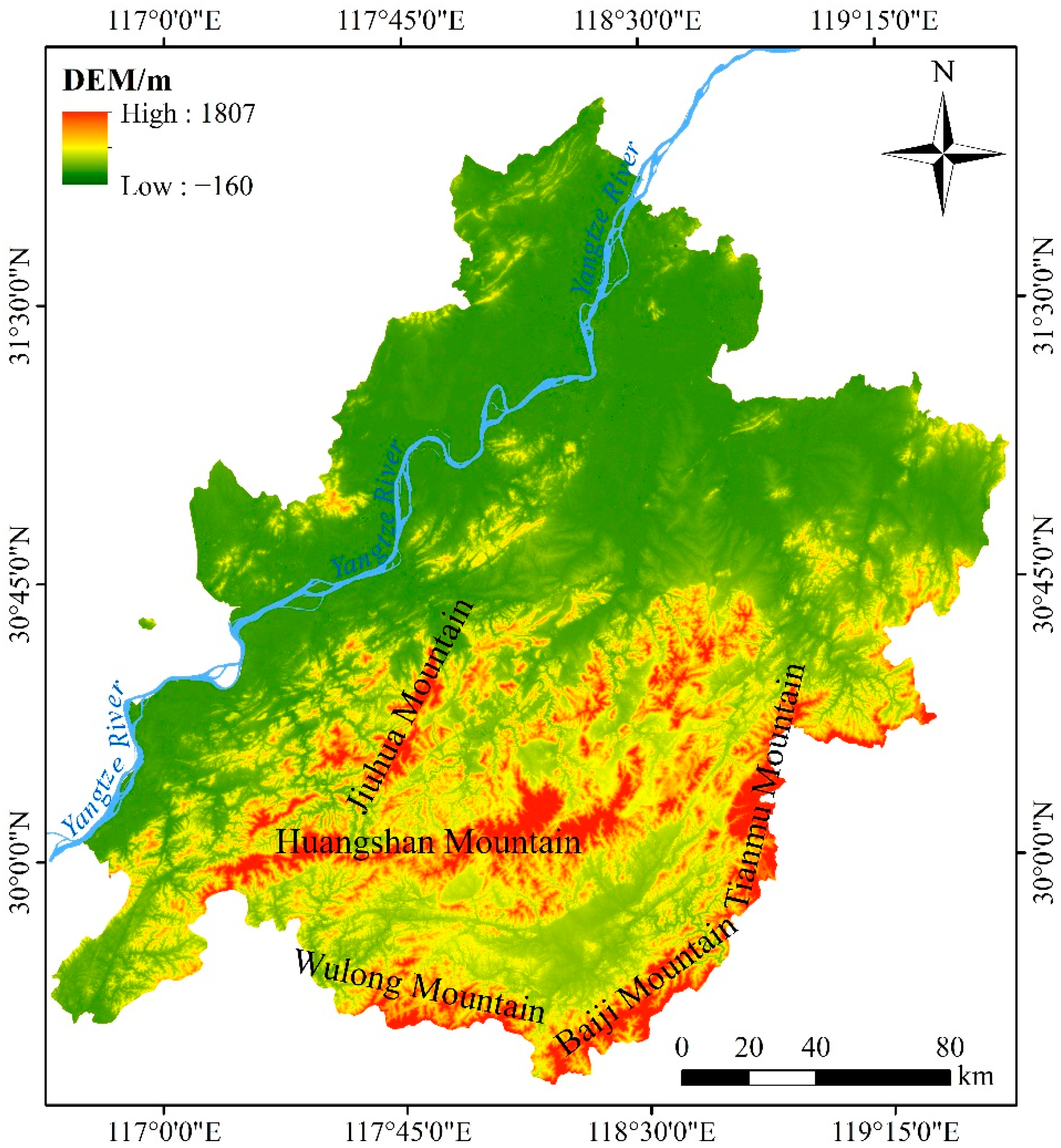

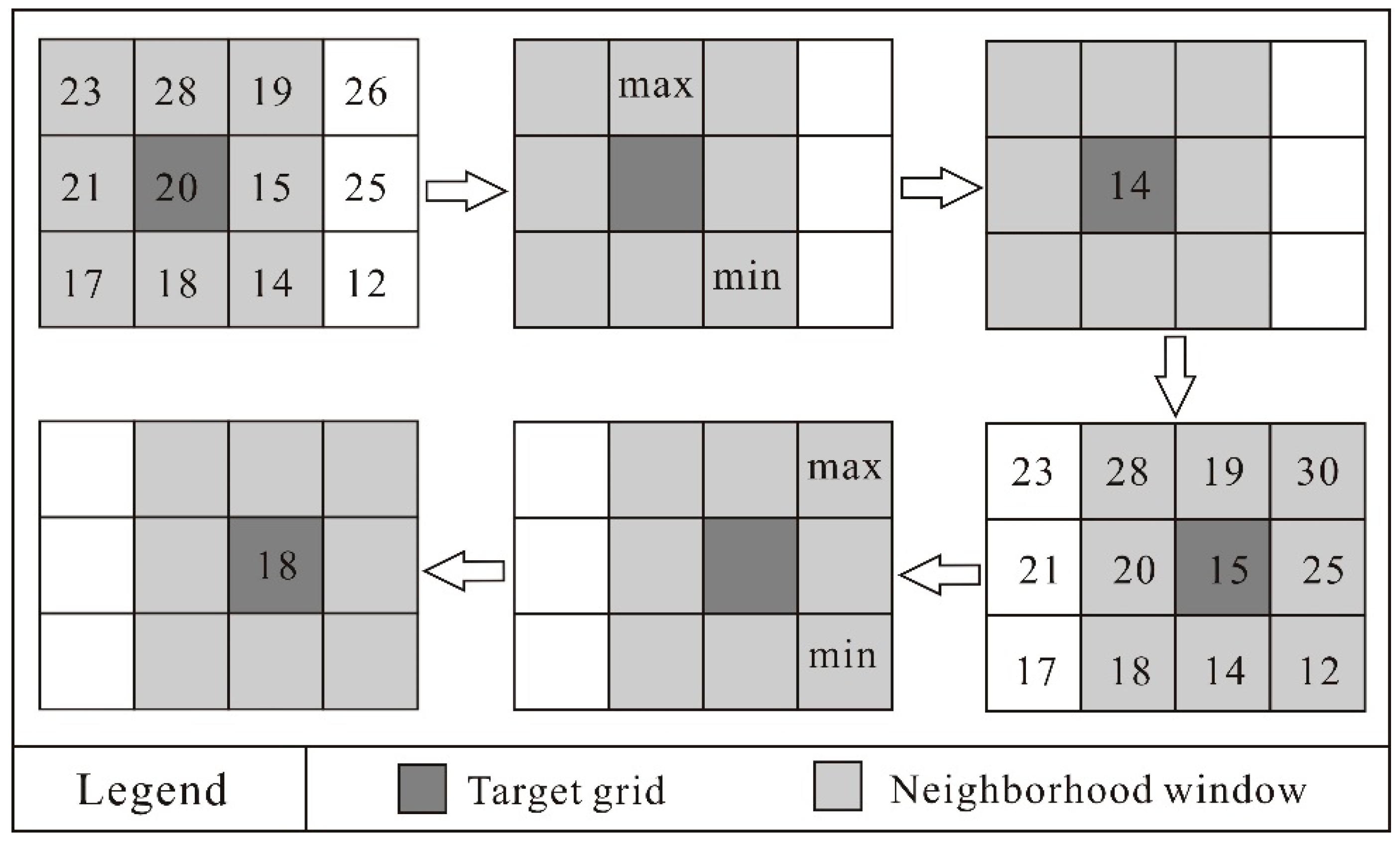
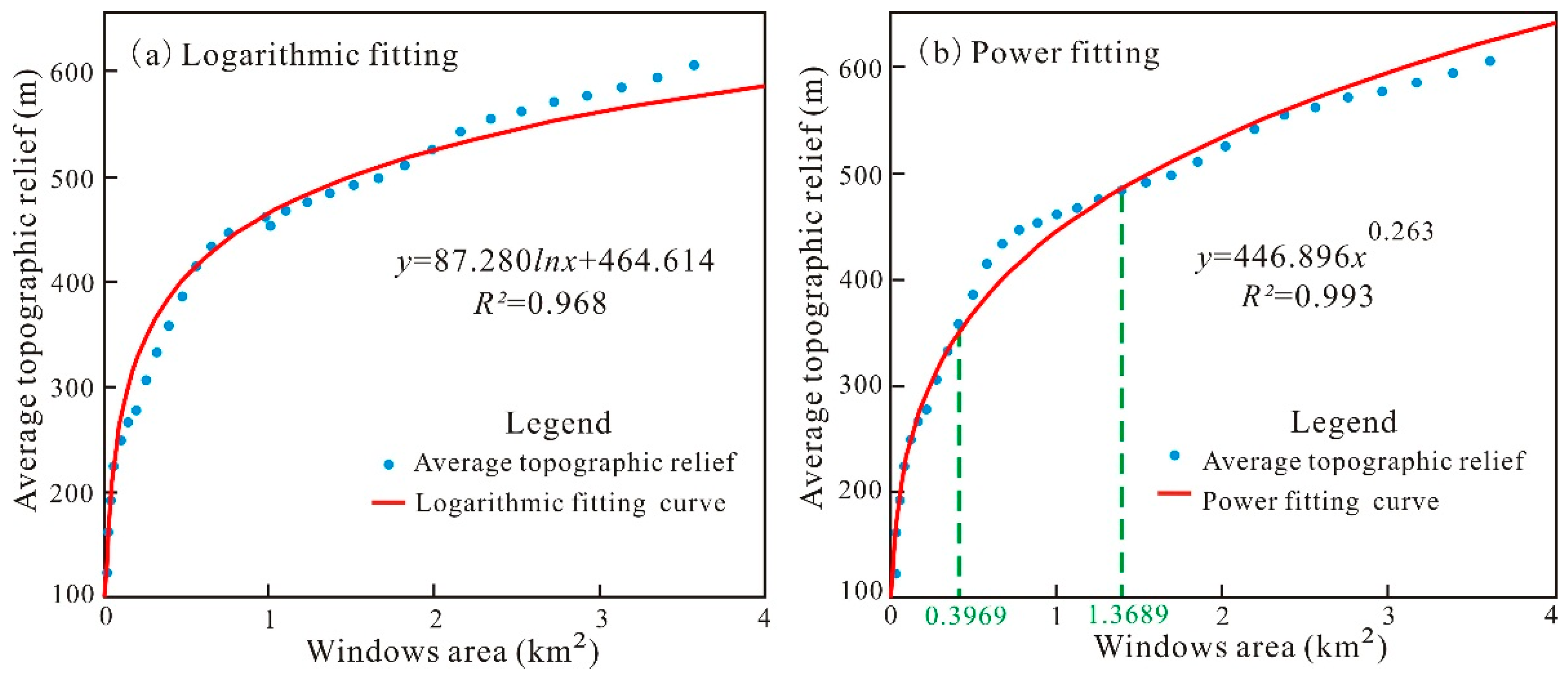


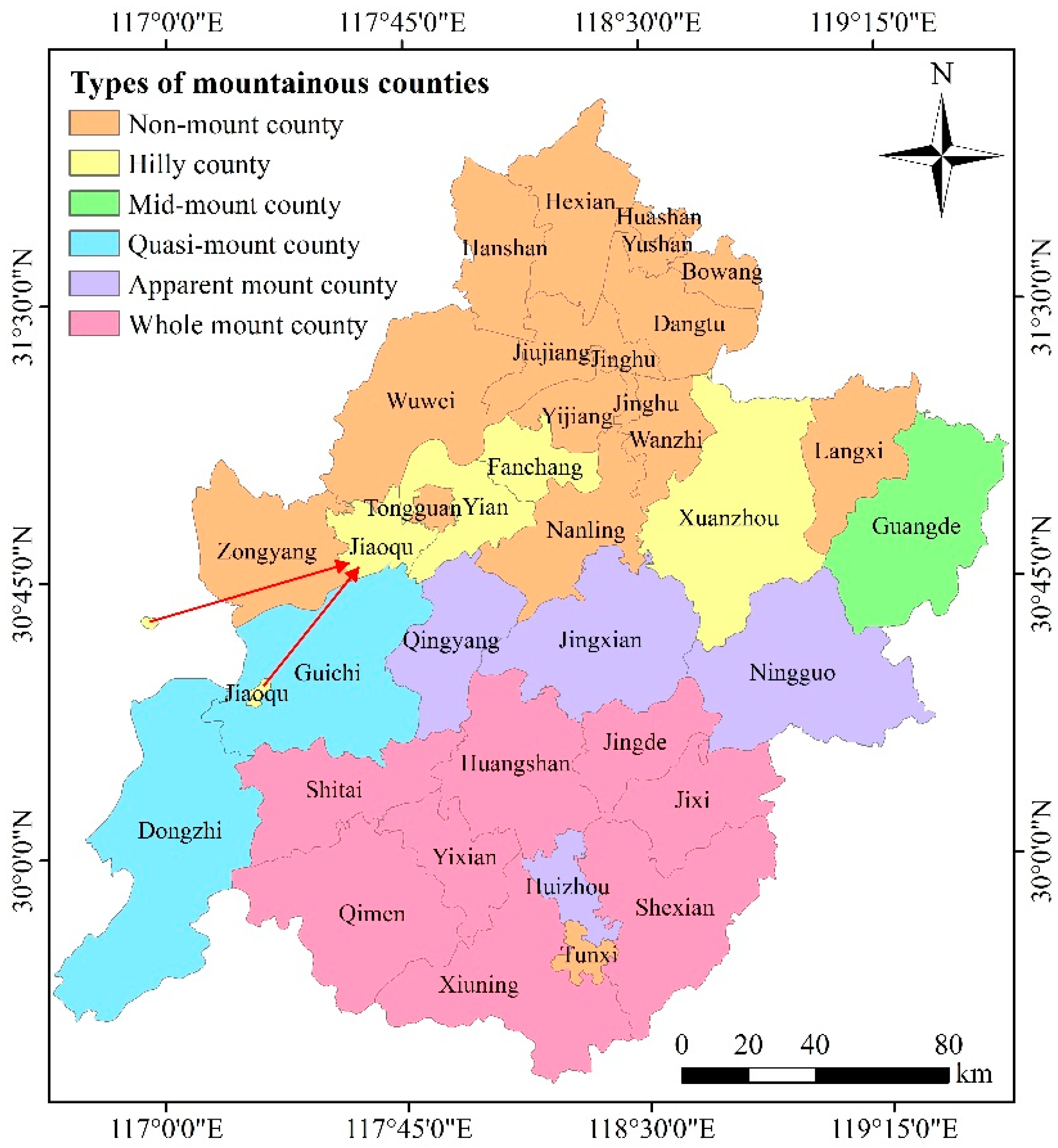
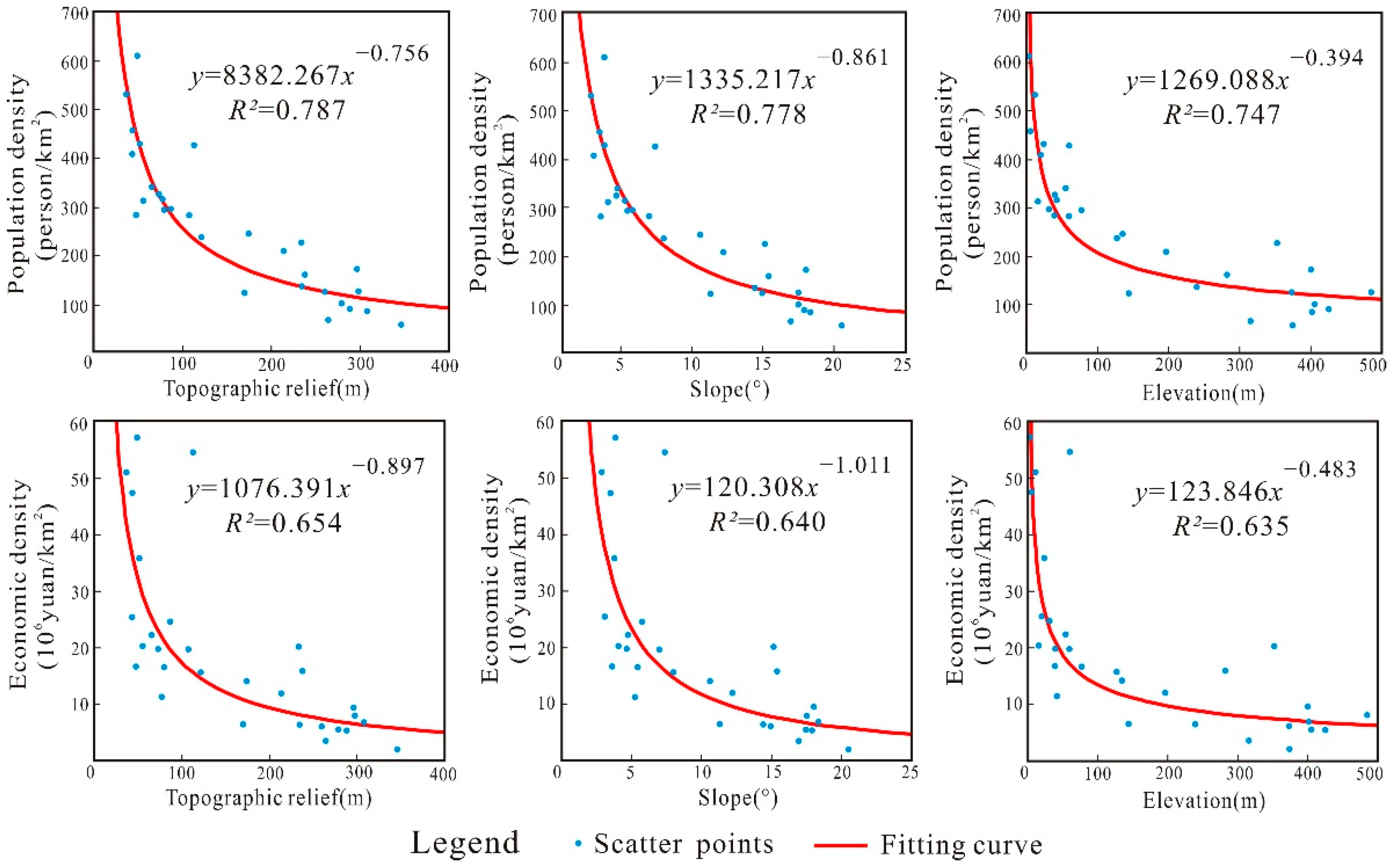
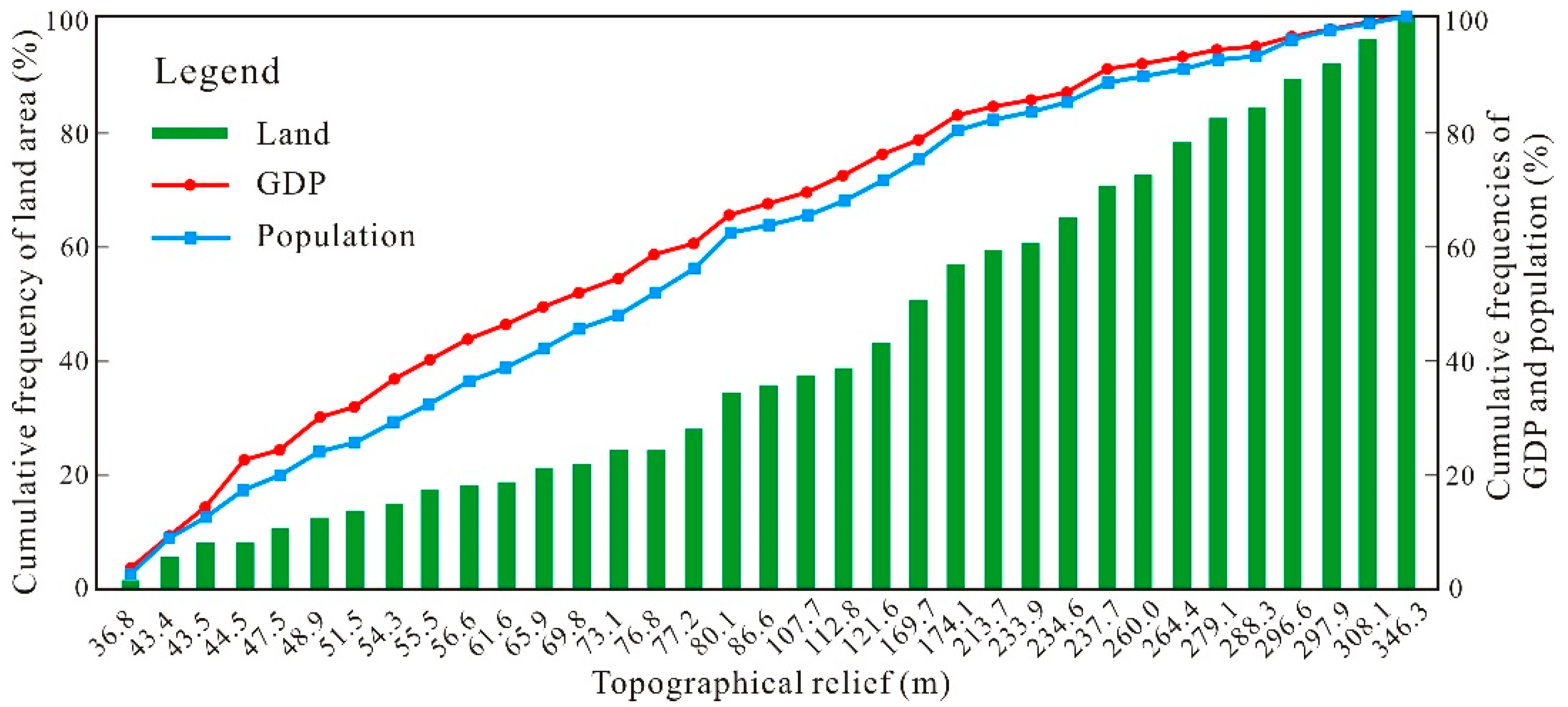
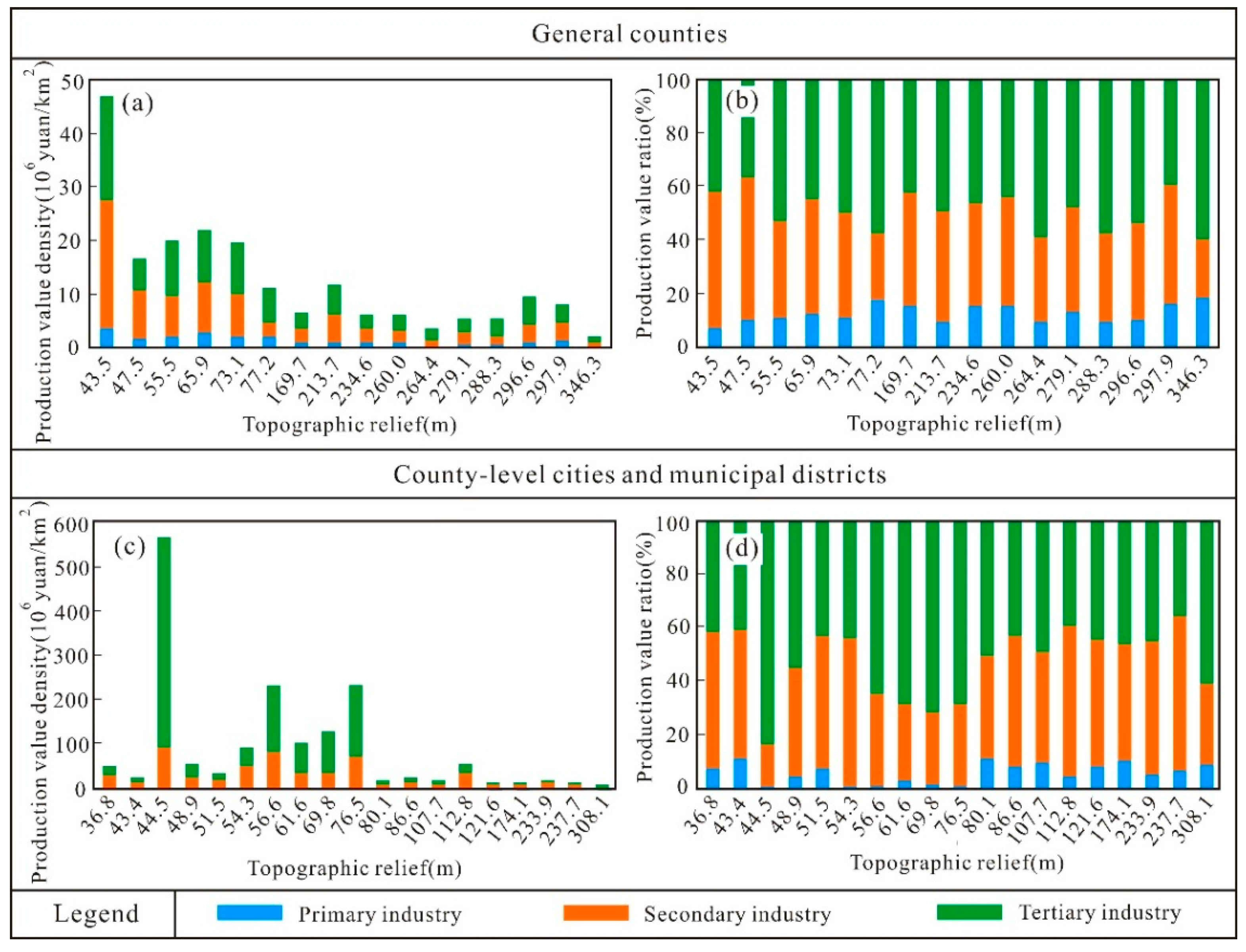

| Window Size | Window Area (km2) | Average Topographic Relief (m) | Window Size | Window Area (km2) | Average Topographic Relief (m) |
|---|---|---|---|---|---|
| 3 × 3 | 0.0081 | 123.18 | 35 × 35 | 1.1025 | 467.57 |
| 5 × 5 | 0.0225 | 161.87 | 37 × 37 | 1.2321 | 475.55 |
| 7 × 7 | 0.0441 | 192.52 | 39 × 39 | 1.3689 | 484.03 |
| 9 × 9 | 0.0729 | 224.68 | 41 × 41 | 1.5129 | 491.50 |
| 11 × 11 | 0.1089 | 249.51 | 43 × 43 | 1.6641 | 498.01 |
| 13 × 13 | 0.1521 | 266.50 | 45 × 45 | 1.8225 | 510.58 |
| 15 × 15 | 0.2025 | 278.03 | 47 × 47 | 1.9881 | 525.27 |
| 17 × 17 | 0.2601 | 306.05 | 49 × 49 | 2.1609 | 542.43 |
| 19 × 19 | 0.3249 | 332.58 | 51 × 51 | 2.3409 | 554.88 |
| 21 × 21 | 0.3969 | 358.07 | 53 × 53 | 2.5281 | 561.88 |
| 23 × 23 | 0.4761 | 386.07 | 55 × 55 | 2.7225 | 571.34 |
| 25 × 25 | 0.5625 | 415.04 | 57 × 57 | 2.9241 | 576.77 |
| 27 × 27 | 0.6561 | 433.59 | 59 × 59 | 3.1329 | 585.09 |
| 29 × 29 | 0.7569 | 446.51 | 61 × 61 | 3.3489 | 594.11 |
| 31 × 31 | 0.8649 | 453.05 | 63 × 63 | 3.5721 | 605.52 |
| 33 × 33 | 0.9801 | 461.53 |
| Landform Types | Number of Pixels (Piece) | Partition Area (km2) | Partition Area Ratio (%) |
|---|---|---|---|
| Flat (0–30 m) | 9,985,315 | 8986.78 | 20.69 |
| Slight relief (30–70 m) | 8,681,664 | 7813.50 | 17.99 |
| Small relief (70–200 m) | 11,487,748 | 10,338.97 | 23.81 |
| Medium relief (200–500 m) | 16,667,262 | 15,000.54 | 34.54 |
| Large relief (≥500 m) | 1,432,551 | 1289.30 | 2.97 |
| Total | 48,254,540 | 43,429.09 | 100.00 |
| Topographic Relief (m) | Population | Economy | Land | Population Density (Person/km2) | Economic Density (104 Yuan/km2) | |||
|---|---|---|---|---|---|---|---|---|
| Total (104 Person) | Proportion (%) | Total (108 Yuan) | Proportion (%) | Area (km2) | Proportion (%) | |||
| ≤80 | 671.76 | 56.34 | 5347.20 | 61.04 | 12,402.36 | 28.56 | 541.64 | 4311.44 |
| 80–115 | 140.99 | 11.82 | 1044.21 | 11.92 | 4565.33 | 10.51 | 308.83 | 2287.26 |
| 115–155 | 49.91 | 4.19 | 329.64 | 3.76 | 2110.95 | 4.86 | 236.43 | 1561.57 |
| 155–195 | 101.37 | 8.50 | 565.46 | 6.45 | 5776.16 | 13.30 | 175.50 | 978.95 |
| 195–245 | 100.86 | 8.46 | 743.25 | 8.48 | 6082.17 | 14.00 | 165.83 | 1222.01 |
| ≥245 | 127.50 | 10.69 | 730.92 | 8.34 | 12,492.13 | 28.76 | 102.06 | 585.10 |
Publisher’s Note: MDPI stays neutral with regard to jurisdictional claims in published maps and institutional affiliations. |
© 2022 by the authors. Licensee MDPI, Basel, Switzerland. This article is an open access article distributed under the terms and conditions of the Creative Commons Attribution (CC BY) license (https://creativecommons.org/licenses/by/4.0/).
Share and Cite
Yang, Z.; Hong, Y.; Guo, Q.; Yu, X.; Zhao, M. The Impact of Topographic Relief on Population and Economy in the Southern Anhui Mountainous Area, China. Sustainability 2022, 14, 14332. https://doi.org/10.3390/su142114332
Yang Z, Hong Y, Guo Q, Yu X, Zhao M. The Impact of Topographic Relief on Population and Economy in the Southern Anhui Mountainous Area, China. Sustainability. 2022; 14(21):14332. https://doi.org/10.3390/su142114332
Chicago/Turabian StyleYang, Zhen, Yang Hong, Qingbiao Guo, Xuexiang Yu, and Mingsong Zhao. 2022. "The Impact of Topographic Relief on Population and Economy in the Southern Anhui Mountainous Area, China" Sustainability 14, no. 21: 14332. https://doi.org/10.3390/su142114332
APA StyleYang, Z., Hong, Y., Guo, Q., Yu, X., & Zhao, M. (2022). The Impact of Topographic Relief on Population and Economy in the Southern Anhui Mountainous Area, China. Sustainability, 14(21), 14332. https://doi.org/10.3390/su142114332







